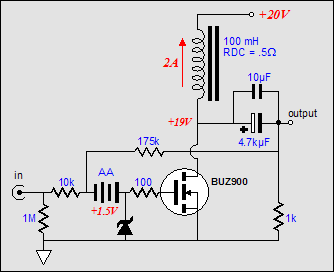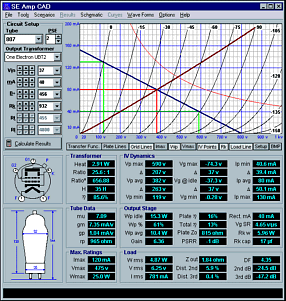| John Broskie's Guide to Tube Circuit Analysis & Design |
Simple SE Amplifiers February 22, 2003 Few in parts, easy to understand, and quick to build, simple amplifiers have a lot going for them. Yet making a great simple amplifier is probably more difficult than making a great complex amplifier, as each part is asked to do so much. For example, in the Zen amplifiers we see a single MOSFET doing all the work of amplifying voltage, driving current into the load, and providing excess gain to power the feedback loop, which is needed to lower the output impedance and distortion— all of which is truly a great deal to ask of one MOSFET. A more complex amplifier might use twenty active devices to accomplish these same goals, with each function performed by a single or group of active devices. Still, an amplifier, which actually gets built is infinitely preferably to the amplifier that doesn’t get built. For every hobbyist-built amplifier in existence there are probably one thousand amplifiers which are planned on being built and maybe one hundred amplifiers that have all their parts collected in a box waiting to be built and ten amplifiers that are partially built and collecting dust in a closet. Thus, with its fewer parts and simpler topology, the tube amplifier stands a better chance of being built than a complex solid-state amplifier. (The same holds true for the complex-tube amplifier or the perfect amplifier; remember: the complex and the perfect are the enemy of the built).  Class-A push-pull hybrid amplifier One problem with simple amplifiers is that do not remain simple. For example, the amplifier shown above is about as simple as a hybrid push-pull amplifier gets; yet the amplifier—as drawn—would not work if actually built as shown; too much is missing. The input triode doesn’t have a consistent path to ground; nor does it have a grid-stopper resistor to prevent ultra-high frequency oscillations; nor does it have any biasing compensation to allow it and the second triode to share the same grid-to-cathode voltage in spite of so greatly dissimilar plate voltages; and the output MOSFETs lack protection circuitry. While adding the missing parts undoes much of the original simplicity, it does make the amplifier usable. Below we see the amplifier fleshed out into a usable Class-A hybrid amplifier that might put out 10-very-listen-able watts, but whose increase complexity would scare most hobbyists away.
Still, compared to most solid-state amplifiers, the amplifier shown above is only half as complex and half as part bloated, yet most neophytes will stare at the schematic and sigh, knowing that they would never attempt to build such a complex amplifier. I remember an amplifier listening session where a few of us recommended to the amplifier’s owner that he add a cathode follower in between amplifier’s input tube and its phase splitter to extend its bandwidth; he turned to us and said, “Just add a cathode follower? You might as well ask me to go to the moon and bring back some rocks.” So what follows is my attempt to describe a few truly simple amplifier topologies that only require that you go to Antarctica and return with some ice.  Single-ended class-A 4W amplifier Of course, simplicity is in the eye of beholder. Few couldn’t build the amplifier shown above in less than a hour (only 4 resistors and 3 active devices) and even fewer wouldn’t describe the amplifier as simple; yet fewer still would realize that the amplifier is, in fact, amazingly complex, with the AD712 and LM317s each holding a huge array of transistors, diodes, and resistors, requiring pages to display accurately in a schematic. Just because the sub-circuits are not drawn does not mean that they are not there. (Do not get me wrong here: I am not saying that this amplifier is a bad design or that it shouldn’t be built; it is, after all, a single-ended class-A amplifier that might be perfect for a computer amplifier.)
Single-Ended Designs
Both amplifiers exploit their target technology. The simplest tube amplifier exploits the average tube linestage’s ability to swing easily ±30 volts; the Zen amplifier, the average solid-state linestage’s ability to work into a low load impedance (4300 ohms). Where these plans fail is when the technologies are swapped: the tube linestage cannot drive 4300 ohms; the solid-state linestage cannot swing ±30 volts. 
Given enough line-stage voltage swing, a feedback loop can even be added to the simple single-ended tube amplifier. In the amplifier shown above, the output is fed into the cathode in the phase as the input; which means that the gain, distortion, and the output impedance are reduced, but the drive requirement goes up. How much? Quite a bit actually, as the 16-ohm tap on the secondary offers 1.4 times more voltage than the 8-ohm tap, so 4 watts output would require 8 volts across the 8-ohm load and 11.3 volts at the cathode and 31 volts at the grid. (In this new topology, the tube is no longer triode-connected. In fact, it works in an ultra-linear fashion, as grid 2 effectively opposes the cathode’s movement.) 
One cheat might be to use the transformer’s own primary resistance to replace the cathode resistor. In the circuit above, we see ground referenced to the cathode and not the power supply’s negative terminal. This sort of topology is actually ancient, in electronic terms, but virtually unknown today. One reader wrote a scathing email to me the last time this journal displayed such a circuit. Unfortunately, I deleted the email long ago, but his contention was that such an amplifier could NOT amplify, as the tube was working as a cathode follower. If the ground connected to the bottom of the transformer’s primary, he would be right, but as it connects to the cathode, the tube actually functions as a grounded-cathode amplifier. If you learn only one thing about tube circuits from this journal, let it be this: just because the load is under the cathode, doesn’t mean the tube has to be functioning as a cathode follower; and conversely, just because the load attaches to the plate doesn’t mean the tube has to be functioning as a grounded-cathode amplifier. The placement of the reference point defines the circuit’s topology: if the reference point is the plate, then the tube is working as a cathode follower; the cathode, a grounded-cathode amplifier. Zen Amplifiers
The maximum theoretical efficiency of such
an amplifier is only 25%. Replacing the constant current source
with an inductor, however, increases the theoretical efficiency
to 50% and allows us to halve the power supply voltage while
still retaining the same power output. If we rework the Pass
Zen amplifier to use an inductor, the circuit at the right develops.
This amplifier functions close the original, but dissipates half
the heat. Still, the same problem of too low an input impedance
remains. 
In the original Pass Zen amplifier, the device MOSFET worked as a constant current source that forced a predetermined amount of current through he bottom MOSFET, whose input bias voltage had to be adjusted to center the output at half of the rail voltage for the largest symmetrical voltage swings (what a drag). But as an ideal inductor displaces no voltage (and real inductors only displace a minute voltage) the amplifier comes pre-centered. (An alternative might be to use only N-Channel MOSFETs and reconfigure the Zen so that the device MOSFET still functions as a constant current source, but a source that auto-centers the output. The amplifier below shows how to make the convergence into the TCJ Zen amplifier.) 
Yet I am still troubled by the need for a large-valued input coupling capacitor and the low input impedance. By using a AA battery, we solve both problems at once. Returning to the inductively-loaded amplifier as an example (the same technique can be used with the previous circuit), we see DC coupling and a higher input impedance. Still, 10k is far too low an impedance for many tube line amplifiers. So why not scale the input and feedback resistors up any further? MOSFETs have a great deal of gate-to-source capacitance, which effectively shorts out the feedback resistor at high frequencies. In other words, the greater the feedback resistor’s value, the lower the high-frequency cutoff frequency. 
Pause and reflect: if we are using a tube line amplifier that can cleanly swing 30 volts, why not exploit that virtue rather than fight the liability of a high output impedance? The circuit at the right is configured as an unity-gain source follower, which offers a high-input impedance and low output impedance and low distortion, but at the cost of a large input voltage swing. This amplifier/buffer uses all of the MOSFET’s transconductance to offer the low output impedance and low distortion, but no gain. With the line amplifier providing all the voltage gain, the amplifier/buffer can concentrate on accurately delivering voltage and current into the load. 
As a test to see if you are following along, does the amplifier in the next schematic function as a buffer (a source follower) or as an amplifier (a grounded-source amplifier)? Is there a global feedback loop? Why aren’t the output coupling capacitors connected to the MOSFET’s source? 
The answer is that the circuit is an amplifier, an amplifier that uses two feedback resistors, the 1M connecting to the positive terminal of the power supply and the 143k resistor that connects to the other end of the inductor. Notice how moving the reference point made all the difference. Conclusion Well, I will stop here at single-ended designs, as the long article is the enemy of the published article. Next time, I will cover simple push-pull amplifiers. //JRB |
Windows 95/98/Me/NT/2000/XP For more information, please visit our Web site :
If you learn only one thing about tube circuits from this journal, let it be this: just because the load is under the cathode, doesn’t mean the tube has to be functioning as a cathode follower; and conversely, just because the load attaches to the plate doesn’t mean the tube has to be functioning as a grounded-cathode amplifier. |
|||
| www.tubecad.com Copyright © 1999-2004 GlassWare All Rights Reserved |















